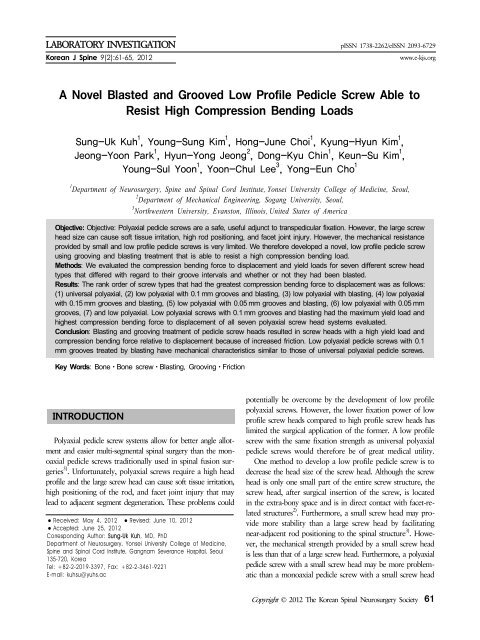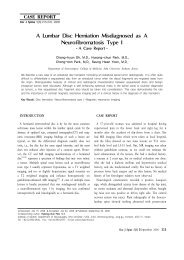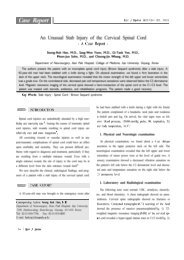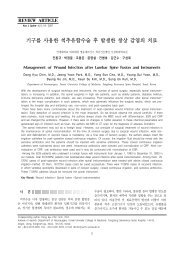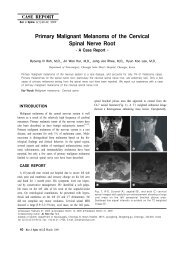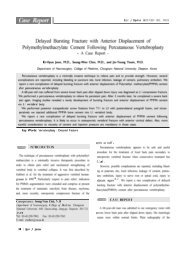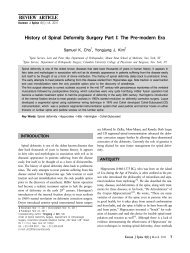A Novel Blasted and Grooved Low Profile Pedicle Screw Able to ...
A Novel Blasted and Grooved Low Profile Pedicle Screw Able to ...
A Novel Blasted and Grooved Low Profile Pedicle Screw Able to ...
Create successful ePaper yourself
Turn your PDF publications into a flip-book with our unique Google optimized e-Paper software.
LABORATORY INVESTIGATION pISSN 1738-2262/eISSN 2093-6729<br />
Korean J Spine 9(2):61-65, 2012 www.e-kjs.org<br />
A <strong>Novel</strong> <strong>Blasted</strong> <strong>and</strong> <strong>Grooved</strong> <strong>Low</strong> <strong>Profile</strong> <strong>Pedicle</strong> <strong>Screw</strong> <strong>Able</strong> <strong>to</strong><br />
Resist High Compression Bending Loads<br />
Sung-Uk Kuh 1 , Young-Sung Kim 1 , Hong-June Choi 1 , Kyung-Hyun Kim 1 ,<br />
Jeong-Yoon Park 1 , Hyun-Yong Jeong 2 , Dong-Kyu Chin 1 , Keun-Su Kim 1 ,<br />
Young-Sul Yoon 1 , Yoon-Chul Lee 3 , Yong-Eun Cho 1<br />
1<br />
Department of Neurosurgery, Spine <strong>and</strong> Spinal Cord Institute, Yonsei University College of Medicine, Seoul,<br />
2<br />
Department of Mechanical Engineering, Sogang University, Seoul,<br />
3<br />
Northwestern University, Evans<strong>to</strong>n, Illinois, United States of America<br />
Objective: Objective: Polyaxial pedicle screws are a safe, useful adjunct <strong>to</strong> transpedicular fixation. However, the large screw<br />
head size can cause soft tissue irritation, high rod positioning, <strong>and</strong> facet joint injury. However, the mechanical resistance<br />
provided by small <strong>and</strong> low profile pedicle screws is very limited. We therefore developed a novel, low profile pedicle screw<br />
using grooving <strong>and</strong> blasting treatment that is able <strong>to</strong> resist a high compression bending load.<br />
Methods: We evaluated the compression bending force <strong>to</strong> displacement <strong>and</strong> yield loads for seven different screw head<br />
types that differed with regard <strong>to</strong> their groove intervals <strong>and</strong> whether or not they had been blasted.<br />
Results: The rank order of screw types that had the greatest compression bending force <strong>to</strong> displacement was as follows:<br />
(1) universal polyaxial, (2) low polyaxial with 0.1 mm grooves <strong>and</strong> blasting, (3) low polyaxial with blasting, (4) low polyaxial<br />
with 0.15 mm grooves <strong>and</strong> blasting, (5) low polyaxial with 0.05 mm grooves <strong>and</strong> blasting, (6) low polyaxial with 0.05 mm<br />
grooves, (7) <strong>and</strong> low polyaxial. <strong>Low</strong> polyaxial screws with 0.1 mm grooves <strong>and</strong> blasting had the maximum yield load <strong>and</strong><br />
highest compression bending force <strong>to</strong> displacement of all seven polyaxial screw head systems evaluated.<br />
Conclusion: Blasting <strong>and</strong> grooving treatment of pedicle screw heads resulted in screw heads with a high yield load <strong>and</strong><br />
compression bending force relative <strong>to</strong> displacement because of increased friction. <strong>Low</strong> polyaxial pedicle screws with 0.1<br />
mm grooves treated by blasting have mechanical characteristics similar <strong>to</strong> those of universal polyaxial pedicle screws.<br />
Key Words: BoneㆍBone screwㆍBlasting, GroovingㆍFriction<br />
INTRODUCTION<br />
Polyaxial pedicle screw systems allow for better angle allotment<br />
<strong>and</strong> easier multi-segmental spinal surgery than the monoaxial<br />
pedicle screws traditionally used in spinal fusion surgeries<br />
5) . Unfortunately, polyaxial screws require a high head<br />
profile <strong>and</strong> the large screw head can cause soft tissue irritation,<br />
high positioning of the rod, <strong>and</strong> facet joint injury that may<br />
lead <strong>to</strong> adjacent segment degeneration. These problems could<br />
● Received: May 4, 2012 ● Revised: June 10, 2012<br />
● Accepted: June 25, 2012<br />
Corresponding Author: Sung-Uk Kuh, MD, PhD<br />
Department of Neurosurgery, Yonsei University College of Medicine,<br />
Spine <strong>and</strong> Spinal Cord Institute, Gangnam Severance Hospital, Seoul<br />
135-720, Korea<br />
Tel: +82-2-2019-3397, Fax: +82-2-3461-9221<br />
E-mail: kuhsu@yuhs.ac<br />
potentially be overcome by the development of low profile<br />
polyaxial screws. However, the lower fixation power of low<br />
profile screw heads compared <strong>to</strong> high profile screw heads has<br />
limited the surgical application of the former. A low profile<br />
screw with the same fixation strength as universal polyaxial<br />
pedicle screws would therefore be of great medical utility.<br />
One method <strong>to</strong> develop a low profile pedicle screw is <strong>to</strong><br />
decrease the head size of the screw head. Although the screw<br />
head is only one small part of the entire screw structure, the<br />
screw head, after surgical insertion of the screw, is located<br />
in the extra-bony space <strong>and</strong> is in direct contact with facet-related<br />
structures 2) . Furthermore, a small screw head may provide<br />
more stability than a large screw head by facilitating<br />
near-adjacent rod positioning <strong>to</strong> the spinal structure 3) . Howe-<br />
ver, the mechanical strength provided by a small screw head<br />
is less than that of a large screw head. Furthermore, a polyaxial<br />
pedicle screw with a small screw head may be more problematic<br />
than a monoaxial pedicle screw with a small screw head<br />
Copyright © 2012 The Korean Spinal Neurosurgery Society 61
SU Kuh, et al.<br />
Fig. 1. The seven different types of pedicle screw evaluated: (A) universal polyaxial screw; (B) low profile polyaxial screw; (C) low profile<br />
polyaxial screw treated with blasting only; (D) low profile screw treated with grooving at 0.05 mm intervals; (E) low profile screw<br />
treated with blasting <strong>and</strong> grooving at 0.05 mm intervals; (F) low profile screw treated with blasting <strong>and</strong> grooving at 0.10 mm intervals<br />
<strong>and</strong> (G) low profile screw treated with blasting <strong>and</strong> grooving at 0.15 mm intervals.<br />
due the ball-<strong>and</strong>-socket-like structural characteristics of polyaxial<br />
pedicle screws.<br />
Our goal in this study was <strong>to</strong> develop a low profile polyaxial<br />
pedicle screw with a small screw head by decreasing the size<br />
of the fixture ball. Furthermore, <strong>to</strong> increase the coefficient of<br />
friction, we created grooves in the fixture ball <strong>and</strong>/or blasted<br />
it <strong>to</strong> improve the mechanical stability of the resulting low<br />
profile polyaxial pedicle screw. We evaluated the compression<br />
bending loads calculated by displacement <strong>and</strong> yield loads for<br />
a variety of screw head types that differed according <strong>to</strong> profile<br />
status, extent of grooves, <strong>and</strong> whether or not the fixture ball<br />
had been blasted.<br />
MATERIAL AND METHODS<br />
We evaluated seven different types of pedicle screws: univer-<br />
sal polyaxial screws, low profile polyaxial screws, low profile<br />
polyaxial screws treated with blasting only (blasting-only screw),<br />
low profile screws treated with grooving at 0.05 mm intervals<br />
(0.05 groove-only screws), low profile screws treated with blas-<br />
ting <strong>and</strong> grooving at 0.05 mm intervals (0.05 groove blasting<br />
screws), low profile screws treated with blasting <strong>and</strong> grooving<br />
at 0.10 mm intervals (0.10 groove blasting screws), <strong>and</strong> low<br />
profile screws treated with blasting <strong>and</strong> grooving at 0.15 mm<br />
intervals (0.15 groove blasting screws) (Fig. 1). <strong>Screw</strong>s were<br />
grooved by machining the fixture ball at regular intervals (Fig.<br />
2) <strong>and</strong> blasting treatment was performed by blasting the fixture<br />
ball of the screw with aluminum oxide(Al2O3)(Fig. 3).<br />
These screws are not commercially available; therefore, we<br />
made pro<strong>to</strong>types for the static compression test. All screws<br />
were made of titanium alloy (Ti-6AI-4V ELI). Furthermore,<br />
the length of the screw shaft was st<strong>and</strong>ardized <strong>to</strong> 40 mm <strong>and</strong><br />
the diameter <strong>to</strong> 6 mm. The screw shaft was potted in an ultra-<br />
high molecular weight polyethylene (UHMWPE) block <strong>and</strong> the<br />
screw head was mounted perpendicularly on a st<strong>and</strong>ardized<br />
rod (Ti-6AI-4V ELI alloy, diameter: 5.0 mm, length: 100.0 mm)<br />
at 1,000 N·cm 1) (Fig. 4). Construct rigidity was measured using<br />
62 www.e-kjs.org<br />
Fig. 2. Schematic illustration of the grooving method. The depth<br />
of the groove (A) was kept constant (0.1 mm) while the groove<br />
interval (B) was varied. The width of the groove (C) was made equal<br />
<strong>to</strong> the groove interval (B).<br />
Fig. 3. Electron microscopic views of a fixture ball pre- <strong>and</strong> postblasting.<br />
The surface of the blasted fixture ball (B) was rougher than<br />
that of the non-blasted fixture ball (A).<br />
a single column-type universal testing machine (RB 302 ML TM ;<br />
R&B Inc., Daejon, Korea) <strong>and</strong> ASTM F1717-09 (st<strong>and</strong>ard test<br />
methods for spinal implant constructs in a vertebrec<strong>to</strong>my model;<br />
ASTM international, West Conshohocken, PA, USA) was used<br />
as the test pro<strong>to</strong>col. Static compression bending force was<br />
applied at a point 40 mm from the screw insertion point perpen-<br />
dicular <strong>to</strong> the long axis of the screw. The compression force<br />
was applied at a rate of 25 mm/min. Outcomes including compressive<br />
bending ultimate load <strong>and</strong> compressive bending yield<br />
load were recorded at set intervals. The compressive bending<br />
yield load was defined as the force that caused a displacement<br />
at 2% offset yield <strong>and</strong> permanent deformation 1) . Each type<br />
of screw was tested five times. Comparison of yield loads based<br />
on screw type was performed using a one-way ANOVA. The<br />
level of significance was set at p
Fig. 4. Setup of the single column-type universal testing machine.<br />
The pedicle screw is encased in UHMWPE blocks, <strong>and</strong> the rod<br />
construct is attached <strong>to</strong> the screw heads. The blocks are com-<br />
pressed at a load rate of 25 mm/min.<br />
Fig. 5. Comparison of the load-displacement curves of monoaxial<br />
<strong>and</strong> polyaxial pedicle screws. The load-displacement curves<br />
show the high rigidity <strong>and</strong> durability of monoaxial pedicle screws.<br />
When the compressive bending force was approximately 200<br />
N, the load-displacement curves of the low profile polyaxial pedicle<br />
screws showed an early plateau caused by slip behaviors at the<br />
interface between the inner surface of the screw head <strong>and</strong> the<br />
fixture ball.<br />
RESULTS<br />
1. Comparison of monoaxial <strong>and</strong> polyaxial screws<br />
To compare the mechanical stability of the monoaxial <strong>and</strong><br />
polyaxial screws, we performed compressive bending tests <strong>and</strong><br />
load displacement curves were recorded for all monoaxial,<br />
<strong>Blasted</strong> <strong>and</strong> <strong>Grooved</strong> <strong>Low</strong> <strong>Profile</strong> <strong>Pedicle</strong> <strong>Screw</strong><br />
Fig. 6. Effect of 0.10 mm grooving <strong>and</strong> blasting treatment. The<br />
combination of blasting <strong>and</strong> 0.10 mm grooving was most effe-<br />
ctive at increasing the yield load of the screw head by increasing<br />
the frictional force. The load-displacement curves of 0.10 mm<br />
grooved <strong>and</strong> blasted screws were similar <strong>to</strong> those of universal polyaxial<br />
pedicle screws. Furthermore, the early plateau of the low<br />
profile polyaxial screws was largely overcome by the grooving <strong>and</strong><br />
blasting treatment.<br />
universal polyaxial, <strong>and</strong> low profile polyaxial screw types. The<br />
universal polyaxial <strong>and</strong> low profile polyaxial screws showed<br />
more displacement for the same increased load amount from<br />
150 <strong>to</strong> 400 N in the load scale compared <strong>to</strong> monoaxial screws,<br />
<strong>and</strong> low profile polyaxial screws showed much more displacement<br />
than universal polyaxial screws due <strong>to</strong> their lower friction<br />
coefficient (Fig. 5). The yield loads (N) of monoaxial, uni-<br />
versal polyaxial, <strong>and</strong> low polyaxial screws were 556±21, 339<br />
±16, <strong>and</strong> 164±15, respectively. The low profile polyaxial screw<br />
showed the lowest yield load, which we attributed <strong>to</strong> a decrease<br />
in frictional force due <strong>to</strong> the small size of the fixture ball.<br />
2. Effects of blasting, grooving, or a combina-<br />
tion treatment<br />
To increase the yield load of low profile polyaxial pedicle<br />
screws, we attempted <strong>to</strong> increase the frictional force between<br />
the fixture ball <strong>and</strong> head by treating the fixture ball with blasting,<br />
grooving, or a combination of both. There was no statisti-<br />
cal difference between the final compressive bending loads<br />
of each treatment group. Blasting-only treatment or grooving<br />
at 0.05 mm intervals increased the yield load significantly com-<br />
pared <strong>to</strong> the no-treatment group. The blasting treatment was<br />
superior <strong>to</strong> 0.05 mm grooving in increasing the yield load.<br />
The yield loads of screws treated with blasting <strong>and</strong> grooving<br />
at 0.05 mm intervals, 0.1 mm intervals, or 0.15 mm intervals<br />
was 285±11, 346±20, <strong>and</strong> 305±21, respectively. The treatment<br />
most effective at increasing the yield load was the combination<br />
of blasting <strong>and</strong> 0.1 mm grooving; screws treated in this<br />
manner had a yield load similar <strong>to</strong> that of universal polyaxial<br />
screws (Figs. 6, 7).<br />
Korean J Spine 9(2) June 2012 63
SU Kuh, et al.<br />
Fig. 7. Yield loads for the various types of screw heads. All treatments<br />
were effective at increasing the yield load of low profile<br />
polyaxial pedicle screws ( * p
loading force in the case of instrument failure. In our study,<br />
all deformations occurred on the rods associated with monoaxial<br />
screws, which experience very high yield loads. In the<br />
polyaxial screw system, primary deformations occurred within<br />
the limits of the angular motion of the polyaxial screw head<br />
<strong>and</strong> rod deformations subsequently developed. Clinically, a<br />
decline in the incidence of rod <strong>and</strong> screw shaft fractures has<br />
been observed over the years since the introduction of polyaxial<br />
screws 4) . This tendency is presumably due <strong>to</strong> the lower<br />
yield load of universal polyaxial screw heads compared <strong>to</strong> the<br />
actual screw or rod. However, <strong>to</strong>o low a yield load can cause<br />
failure of post-operative spinal alignment, cage subsidence due<br />
<strong>to</strong> instability, <strong>and</strong> bone fusion failure. We demonstrated that<br />
grooving <strong>and</strong> blasting treatment can effectively increase the<br />
low yield load of low profile polyaxial screw heads. With<br />
technical advancements in blasting <strong>and</strong> grooving treatments,<br />
we anticipate the development of low profile polyaxial screws<br />
with ideal yield loads.<br />
CONCLUSION<br />
We found that treatment of the ball fixture of low profile<br />
polyaxial screws by blasting <strong>and</strong> grooving increased the yield<br />
load of the screw head by increasing the frictional force. These<br />
methods can therefore be used <strong>to</strong> produce low profile polyaxial<br />
screws with compression bending load values similar <strong>to</strong><br />
displacement <strong>and</strong> yield load values.<br />
<strong>Blasted</strong> <strong>and</strong> <strong>Grooved</strong> <strong>Low</strong> <strong>Profile</strong> <strong>Pedicle</strong> <strong>Screw</strong><br />
Acknowledgement<br />
This paper was presented at The Korean Neurosurgical Society<br />
Meeting in April 2011.<br />
This work has been financially supported by Genoss Com-<br />
pany.<br />
REFERENCES<br />
1. ASTM international: St<strong>and</strong>ard test methods for spinal implant<br />
constructs in a vertebrec<strong>to</strong>my model. ASTM F1717-1709<br />
2. Chen Z, Zhao J, Xu H, Liu A, Yuan J, Wang C:Technical fac<strong>to</strong>rs<br />
related <strong>to</strong> the incidence of adjacent superior segment facet<br />
joint violation after transpedicular instrumentation in the lumbar<br />
spine. Eur Spine J 17:1476-1480, 2008<br />
3. Crawford NR, Doüan S, Yűksel KZ, Villasana-Ramos O, So<strong>to</strong>-<br />
Barraza JC, Sawa AG, et al: In vitro biomechanical analysis<br />
of a new lumbar low-profile locking screw-plate construct versus<br />
a st<strong>and</strong>ard <strong>to</strong>p-loading cantilevered pedicle screw-rod construct:<br />
technical report. Neurosurgery 66:404-406, 2010<br />
4. Fogel GR, Reitman CA, Liu W, Esses SI: Physical characteristics<br />
of polyaxial-headed pedicle screws <strong>and</strong> biomechanical comparison<br />
of load with their failure. Spine 28:470-473, 2003<br />
5. Lim HJ, Kwon SC, Roh SW, Jeon SR, Rhim SC: Outcomes<br />
of unilateral transforaminal lumbar interbody fusion in degenerative<br />
lumbar spine disease: Korean J Spine 2(1):19-25, 2005<br />
6. Polly DW, Orchowski JR, Ellenbogen RG: Revision pedicle<br />
screws: bigger, longer shims-what is best? Spine 23:1374-1379, 1998<br />
7. Shepard MF, Davies MR, Abayan A, Kabo JM, Wang JC: Effects<br />
of polyaxial pedicle screws on lumbar construct rigidity. J Spinal<br />
Disord Tech 15:233-136, 2002<br />
Korean J Spine 9(2) June 2012 65


